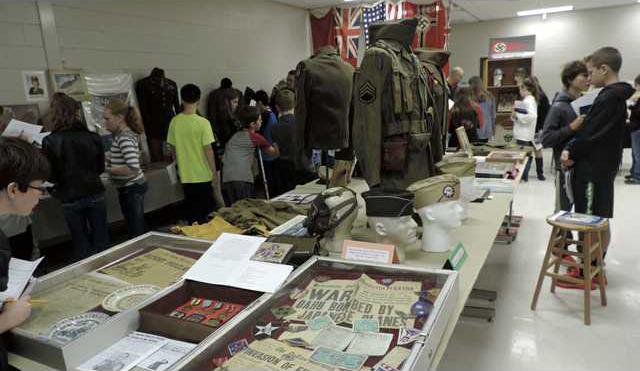During World War II, American troops crossed oceans. But on Dec. 11, some Gainesville students crossed time to experience some of those darkest moments in modern history.
Thanks to an open science lab doubling as a time machine, sixth-graders at C.W. Davis Middle school were transported back to the era of World War II.
For the day, the lab was filled with memorabilia and heirlooms from the Axis and Allied military forces as well as elements from their home countries, creating a makeshift museum. At its center was a table with uniforms displayed as if they were still standing at attention despite the passage of time.
Before each student group jumped into the early 1940s, sixth-grade social studies teacher and history buff Ryan Hartrick issued a reminder.
“Everything in here belonged to a real person, and they paid a high price. Whether with their life or their innocence, because they had to grow up … fast,” said Hartrick, who spearheaded the idea for the museum. “I wanted to find a way to honor my grandfather, (a WWII veteran) and bring him closer to us, as well as his entire generation.”
To give students a personal experience, each group had its own tour guide and heard stories from Hartrick and his co-teacher, Clifford Orth, about the pieces in the display. The tales helped students connect the pieces with people.
For example, sixth-grader John Bergmann listened as Hartrick explained one part of a plane made its way from America to Great Britain and then crashed over the then-USSR. The plane now resides in Pensacola, Fla.
He also learned about the real people who experienced the real events.
One real person was a young man who enlisted in 1942 and served in North Africa, Belgium and various parts of Italy. He was killed in action in Holland, serving in Operation Market Garden.
Bergmann and his classmates saw the serviceman’s medals, photograph and letter to his family notifying them of his death.
Alongside the case were a topographical map and a small booklet. As students peered closer, they saw the booklet was a diary, with the last entry referring to the soldier’s company crossing the river depicted in the map.
Sixth-graders Kiara Santillan and Ariana Giraldo, both of Flowery Branch, had a moment of stunned silence as they took in what happened to this man.
Once they absorbed the shock, the two girls admitted they could not imagine what the young American man must have felt in a strange place such as Holland, fighting the Axis powers.
The museum did not only focus on the military actions of the war. Students glimpsed into the lifestyles women in the 1940s on the homefront. One item signifying the life at home was an ad to join the Red Cross, which made several girls cringe.
In the picture, the solely female nurses were posed and appeared attractive. On the flip side, the pictures of the male soldiers seemed more candid sitting on a tank.
“What if we wanted to join the military? They said only guys could do it, but we were back home building bombs for them,” Autumn Austin said.
Sixth-grader Lilly Schacht said it seemed unfair.
“I think I would’ve joined because they’re our soldiers,” she said. “But I would’ve wanted to be something bigger ... They were saying women could only be nurses, but I would want to prove them wrong.”
Seeing the expectations of women back then helped the girls realize the strides women have made. They understood how far equality has come through the efforts of bold women in that greatest generation.
The visuals also were not limited to the United States’ point of view. Students saw what life was like in Japan and Germany at the time.
When looking at a book from Nazi Germany about Adolf Hitler, sixth-grader Aidan Boone said “When I look at this, I’m thinking a little bit of … sadness.”
His fellow students nodded in agreement, remembering many German citizens thought they were doing what was right for their country.
Overall, spending time around the world in the 1940s let history come to life for students. It reminded them of the cost of the freedoms they enjoy in America.
“I think the museum went great.” Hartrick said. “When the kids can see, touch and feel items that have ‘been there and done that’ and be enveloped by the stories of our nation’s greatest, they always seem to truly understand the message.”

